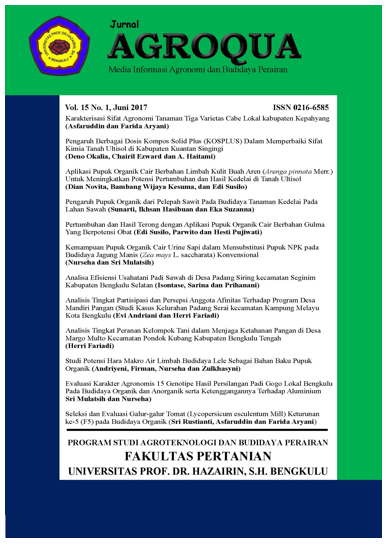FORMULASI DAN KARAKTERISTIK MUTU SNACK BAR BERBASIS TEPUNG PISANG JANTAN (Musa paradisiaca var paradisiaca) DAN TEPUNG AMPAS TAHU
DOI:
https://doi.org/10.32663/ja.v20i2.3179Keywords:
functional food, composition, diet snackAbstract
Snack bar is a snack that is practically formulated as a food to hunger delay, contains carbohydrates, protein, and fiber, with wheat as the main ingredient. The purpose of this study was to determine the best formulation of “jantan” banana flour and tofu dregs flour in making snack bars according to the characteristics of physical, chemical, and organoleptic qualities. The methods in this study include the processing of banana flour, tofu dregs flour, and snack bar processing with the composition treatment of “jantan”banana flour and tofu dregs flour 100: 0, 80: 20, 60: 40, 40: 60, 20: 80, 0: 100. The analysis in this study included the water content of “jantan” banana flour and tofu dregs flour as well as the yield, texture, water content, protein content, fiber content and organoleptic snack bar. The results showed that the water content of “jantan” banana flour was 7,23% while tofu dregs flour was 9,45%. The results of the snack bar yield analysis ranged from 53,8% to 66,7%. The texture of the snack bar ranged from 12,33 mm to 34,67 mm. The average value of the water content of the snack bar is between 1,32% to 1,88%. The protein content of snack bars is between 6,64% to 8,16%. The fiber content of the snack bar ranges from 5,63% to 8,45%. The average result of organoleptic analysis of snack bar colors is between 3,25 (rather like) to 3,50 (rather like). The average snack bar taste value is between 2,65 (rather like) to 3,90 (like). The average value of the snack bar aroma is between 2,45 (dislike) to 3,66 (like). The average value of the snack bar texture is between 2,85 (rather like) to 3,75 (like).
References
Downloads
Published
Issue
Section
License
Authors who publish with this journal agree to the following terms:
- Authors grant the journal right of first publication with the work simultaneously licensed under a Creative Commons Attribution 4.0 Internasional (CC BY 4.0) Licence that allows others to use and share the work with an acknowledgment of the work's authorship and initial publication in this journal.
- The author(s) still hold the copyright of his/her/their work and retain publishing rights without restrictions such as (but not limited to) patent right, lecture, book and reproduce the article for own purposes.
















